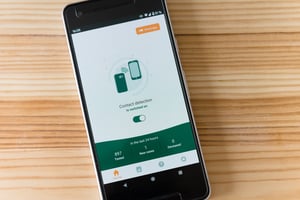Working from home has become a popular option for many Americans. About 43% of workers regularly...
Are World Wide Shipping Disruptions here to Stay?
As countries continue to vaccinate people against COVID-19 and provide booster vaccinations to achieve herd immunity, it has become clear that economic recovery will take longer than most people probably expected and, in some cases, much longer. One obvious cause of the delay was the discovery of the Delta variant, and now the Omicron variant.
We have come to expect the annual flu season and the availability of vaccines for most known strains. These vaccines can prevent the flu, lessen the symptoms, and/or shorten recovery. About 3 million Americans contract Influenza each year. For most, the symptoms are relatively short-lived and not life-threatening. We also know that a flu virus can mutate. Usually variants occur every few years, which gives scientists and pharmaceutical manufacturers time to discover and track these variants.
COVID-19 was different. Both Influenza and COVID are contagious respiratory diseases. Influenza results from an infection of known Type A or Type B influenza viruses. COVID is an infection from the COVID virus discovered in 2019. COVID can cause more serious symptoms and illnesses in some people. Symptoms of COVID may take longer to present than influenza, and some people with the virus can be contagious for longer than the normal incubation period for influenza. Because symptoms for both diseases can be similar, COVID testing is the only way to diagnose the cause accurately. Moreover, people can be infected with the flu and COVID at the same time (for the latest information on COVID-19, please click here.)
Once researchers discovered the COVID virus, they tested the effectiveness of known vaccines to prevent or lessen the severity of the symptoms. As we all know now, we didn’t have years to study and test, and we didn’t have an existing effective vaccine. The first cases appears to have been reported December 8, 2019, in Wuhan, China. It spread quickly, through cities that are entry points for foreign travelers. As of November 19, 2021, the United States reports more cases (47,661,242) and more deaths (770,691) than any other country. Varying symptoms, long dormancy periods, and a higher death rate than the flu gave rise to a global cooperative to find a vaccine.
The other unwelcomed surprise was the Delta COVID virus variant, which made its debut as the vaccinations for the original strain were in distribution. A recent article in The Atlantic by Amanda Mull summed up the sentiment of many Americans thusly, ”[T]he maddeningly unpredictable Delta variant has changed the expected course of the coronavirus pandemic so much that it can be hard to know exactly what you’re waiting for, or if you should continue waiting at all. Is something like before-times normalcy still coming, or will Americans have to negotiate a permanently changed reality?”
The most immediate and obvious lesson from the pandemic is that the U.S. has become sorely dependent on foreign sources for medical device components and other vital medical supplies. From the availability of tests and testing sites, to disagreement about containment measures, to the lack of Personal Protective Equipment (“PPE”) and ventilators, it is clear not only that the U.S. was unprepared for such a global catastrophe, but that that foreign powers could (and did) leverage our dependence during an emergency for their economic advantage.
Another emerging realization is how acutely dependent this country is on a perpetually moving supply chain for life-sustaining needs like food, medicine, and clothing. The global lockdowns imposed in 2020 to slow the spread of COVID-19 in China, disrupted the supply side in global shipping. As this was occurring, there was a surge in demand in the U.S. and other countries for electronics produced in China to facilitate telework, driving prices up significantly.
The shortage of labor in positions such truck driving and logistics have contributed to delays in getting dock space and scheduling. Seventy-seven percent of the world’s ports are experiencing longer-than-usual wait times. Thousands of ships remained docked near U.S. and Chinese ports waiting for dock space, including vessels with critical necessities. Wait times, in turn, have sent shipping costs skyrocketing by as much as 300%, and manufacturers of low profit goods are holding off on shipments until the “log jam” abates. Other products and services have increased significantly due to shipping delays, labor shortages, and lockdowns, too. These include household furnishings, travel, transportation, medicine and medical supplies, cars, and food. Some experts predict that it could take up to two more years before most supply chains are “back to normal.”
It is interesting to note that more and more businesses have embraced the concept of just-in-time (“JIT”) inventory to reduce operating costs. This concept could benefit the U.S. in several ways. The JIT model requires manufacturers to be closer to their suppliers to shorten supply chains. On-shoring production not only eliminates the cost of long-distance shipping, improves the strength and viability of supply chains, and makes domestic products more attractive to consumers, but it just might be a crucial part of America’s global crisis preparedness plan.



